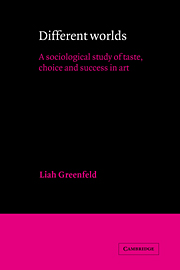Book contents
- Frontmatter
- Contents
- Introduction
- 1 Historical background
- 2 The population of painters and the split into subsystems
- 3 Patterns of success
- 4 The “gatekeepers” – critics
- 5 The “gatekeepers” – curators
- 6 The “gatekeepers” – gallery owners
- 7 The artists – attitudes of Conceptualists and Lyrical Abstractionists
- 8 The artists – attitudes of figurative painters
- 9 The publics
- 10 Conclusion
- Appendices
- Notes
- Index
- Titles in the series
1 - Historical background
Published online by Cambridge University Press: 16 September 2009
- Frontmatter
- Contents
- Introduction
- 1 Historical background
- 2 The population of painters and the split into subsystems
- 3 Patterns of success
- 4 The “gatekeepers” – critics
- 5 The “gatekeepers” – curators
- 6 The “gatekeepers” – gallery owners
- 7 The artists – attitudes of Conceptualists and Lyrical Abstractionists
- 8 The artists – attitudes of figurative painters
- 9 The publics
- 10 Conclusion
- Appendices
- Notes
- Index
- Titles in the series
Summary
The pre-State period: intelligible art
The history of Israeli painting begins with the establishment of the Bezalel art school in Jerusalem in 1906. Since this time Israeli art has undergone many important changes. In seventy years the artists of this country traversed a path which in other countries lasted twice that time. This pace resulted in the simultaneous existence of numerous styles which developed side by side in a relatively small place. All these styles were imported to Israel; none was indigenous. At most the subjects took on local shades. In the majority of cases, when a certain style appeared in Israel and was beginning to spread there, it usually already ruled abroad. However, different styles which exist in Israel today were not accepted simultaneously. The order of their appearance, roughly parallel to the sequence of their emergence abroad, was among other things, an expression of the changing relationship between art and society in Israel and of the place and role of the artist in this society.
Bezalel gave its name to the first style of Israeli art. Its chief characteristic was academic Naturalism or Realism which incorporated the elements of German Jugendstil and oriental ornamentics. The ideology it was based on required unity between the artist and the ideals of his people, which explained its main subjects: heroes of the Old Testament, contemporary Jewish leadership and Holy Places in Palestine.
The activities the Bezalel school engaged in were not purely or even primarily artistic activities.
- Type
- Chapter
- Information
- Different WorldsA Sociological Study of Taste, Choice and Success in Art, pp. 9 - 41Publisher: Cambridge University PressPrint publication year: 1989

